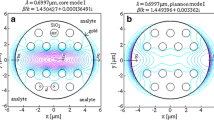Abstract
Samarium doped chalcogenide core, perfluorinated polymer clad with Ag metal and plasmonic 2D materials based plasmonic fiber-optic sensor is simulated and analyzed in near-infrared (NIR) wavelength regime. Proposed sensor is directed at the detection of the malignancy stages of liver tissues. The performance analysis (in terms of figure-of-merit, i.e., FOM) was carried out taking into account the MoS2 and graphene monolayers as performance enhancing 2D materials. The analysis suggests that FOM values of MoS2-based sensor probe are better than graphene-based probe. Further, a comparative study shows that fiber-optic probe is able to provide much better performance than prism-based probes. The FOM gets better for longer wavelength. The specificity of the biosensor can be improved by employing a suitable buffer layer (1–15 nm) as a bio-recognition element.





Similar content being viewed by others
References
Vaisocherová-Lísalová, H., et al. (2016). Low-fouling surface plasmon resonance biosensor for multi-step detection of foodborne bacterial pathogens in complex food samples. Biosensors & Bioelectronics, 80, 84–90. https://doi.org/10.1016/j.bios.2016.01.040.
Wang, X. D., & Wolfbeis, O. S. (2016). Fiber-optic chemical sensors and biosensors (2013–2015). Analytical Chemistry, 88(1), 203–227. https://doi.org/10.1021/acs.analchem.5b04298.
Nguyen, B. H., & Nguyen, V. H. (2016). Advances in graphene-based optoelectronics, plasmonics and photonics. Advances in Natural Sciences: Nanoscience and Nanotechnology, 7(1). https://doi.org/10.1088/2043-6262/7/1/013002.
Sharma, A. K., Jha, R., & Gupta, B. D. (2007). Fiber-optic sensors based on surface plasmon resonance: A comprehensive review. Sensors Journal, IEEE, 7(8), 1118–1129. https://doi.org/10.1109/JSEN.2007.897946.
Homola, J. (2008). Surface plasmon resonance sensors for detection of chemical and biological species. Chemical Reviews, 108(2), 462–493. https://doi.org/10.1021/cr068107d.
Wang, Y., Meng, S., Liang, Y., Li, L., & Peng, W. (2013). Fiber-optic surface plasmon resonance sensor with multi-alternating metal layers for biological measurement. Photonic Sensors, 3(3), 202–207. https://doi.org/10.1007/s13320-013-0119-2.
Pollet, J., et al. (2009). Fiber optic SPR biosensing of DNA hybridization and DNA-protein interactions. Biosensors & Bioelectronics, 25(4), 864–869. https://doi.org/10.1016/j.bios.2009.08.045.
Sharma, A. K., & Kaur, B. (2018). Chalcogenide fiber-optic SPR chemical sensor with MoS2 monolayer, polymer clad, and polythiophene layer in NIR using selective ray launching. Optical Fiber Technology, 43(March), 163–168. https://doi.org/10.1016/j.yofte.2018.05.003.
Kim, J. A., Hwang, T., Dugasani, S. R., Amin, R., Kulkarni, A., Park, S. H., et al. (2013). Graphene based fiber optic surface plasmon resonance for bio-chemical sensor applications. Sensors and Actuators, B: Chemical, 187, 426–433. https://doi.org/10.1016/j.snb.2013.01.040.
Patskovsky, S., Kabashin, A. V., Meunier, M., & Luong, J. H. T. (2003). Properties and sensing characteristics of surface-plasmon resonance in infrared light. Journal of the Optical Society of America. A, 20(8), 1644–1650. https://doi.org/10.1364/josaa.20.001644.
Hecht, E. (2002). Optics (4th ed.). London: Pearson Education.
Isayev, A. I., Atayeva, S. U., Mehdiyeva, S. I., & Zeynalov, V. Z. (2014). Optical properties of chalcogenide glassy semiconductor Se95Te5 doped by samarium. FIZIKA, XX(3), 25–29.
Ishigure, T., Koike, Y., & Fleming, J. W. (2000). Optimum index profile of the perfluorinated polymer-based GI polymer optical fiber and its dispersion properties. Journal of Lightwave Technology, 18(2), 178–184. https://doi.org/10.1109/50.822790.
Djuris, A. B., Elazar, J. M., & Majewski, M. L. (1998). Optical properties of metallic films for vertical-cavity optoelectronic devices, 37(22), 5271–5283.
Giannios, P., Toutouzas, K. G., Matiatou, M., Stasinos, K., Konstadoulakis, M. M., Zografos, G. C., et al. (2016). Visible to near-infrared refractive properties of freshly-excised human-liver tissues: Marking hepatic malignancies. Scientific Reports, 6, 1–10. https://doi.org/10.1038/srep27910.
Gupta, B. D., & Sharma, A. K. (2005). Sensitivity evaluation of a multi-layered surface plasmon resonance-based ber optic sensor: a theoretical study. Sensors and Actuators B: Chemical, 107, 40–46. https://doi.org/10.1016/j.snb.2004.08.030.
Aćimović, S. S., et al. (2014). LSPR Chip for parallel, rapid, and sensitive detection of cancer markers in serum. Nano Letters, 14, 2636–2641. https://doi.org/10.1021/nl500574n.
Choi, J. W., et al. (2008). Ultra-sensitive surface plasmon resonance based immunosensor for prostate-specific antigen using gold nanoparticle-antibody complex. Colloids and Surfaces A: Physicochemical and Engineering Aspects, 313–314, 655–659. https://doi.org/10.1016/j.colsurfa.2007.05.057.
Di Tommaso, L., & Roncalli, M. (2017). Tissue biomarkers in hepatocellular tumors: Which, when, and how. Frontiers in Medicine, 4, 1–7. https://doi.org/10.3389/fmed.2017.00010.
Wang, C., Zhang, Y., Guo, K., Wang, N., Jin, H., Liu, Y., et al. (2016). Heat shock proteins in hepatocellular carcinoma: Molecular mechanism and therapeutic potential. International Journal of Cancer, 138(8), 1824–1834. https://doi.org/10.1002/ijc.29723.
Masson, L., Mazza, A., & Crescenzo, G. De. (2000). Determination of affinity and kinetic rate constants using surface plasmon resonance. Methods in Molecular Biology, 145, 189–201.
Beal, A. R., & Hughes, H. P. (1979). Kramers–Kronig analysis of the reflectivity spectra of 2H-MoS2, 2H-MoSe2 and 2H-MoTe2. Journal of Physics C: Solid State Physics, 12(5), 881–890. https://doi.org/10.1088/0022-3719/12/5/017.
Weber, J. W., Calado, V. E., & Van De Sanden, M. C. M. (2010). Optical constants of graphene measured by spectroscopic ellipsometry. Applied Physics Letters, 97(9), 0919041–0919043. https://doi.org/10.1063/1.3475393.
Ignatyeva, D. O., Sekatskii, S. K., Khokhlov, N. E., Nur-E-Alam, M., Vasiliev, M., Alameh, K., & Belotelov, V. I. (2016). Enhancement of SPR-sensor sensitivity in garnet-based plasmonic heterostructures. In Proceedings of 2016 Progress in electromagnetics research symposium, PIERS 2016 (pp.831–835). https://doi.org/10.1109/piers.2016.7734494.
Sharma, A. K., & Kaur, B. (2018). Simulation and analysis of 2D material (MoS2/MoSe2) based plasmonic sensor for measurement of organic compounds in infrared. Optik, 157, 161–169. https://doi.org/10.1016/j.ijleo.2017.11.067.
Acknowledgements
Baljinder Kaur acknowledges the MHRD (India) for support in form of research assistantship. This work is partially supported by the CSIR (India) project Grant no. 03(1441)/18/EMR-II.
Author information
Authors and Affiliations
Corresponding author
Rights and permissions
About this article
Cite this article
Kaur, B., Sharma, A.K. Plasmonic Biosensor in NIR with Chalcogenide Glass Material: On the Role of Probe Geometry, Wavelength, and 2D Material. Sens Imaging 19, 36 (2018). https://doi.org/10.1007/s11220-018-0220-0
Received:
Revised:
Published:
DOI: https://doi.org/10.1007/s11220-018-0220-0




